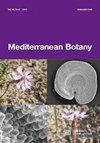利用原位高光谱数据评价草原冠层含水量
IF 0.7
4区 生物学
Q3 PLANT SCIENCES
引用次数: 0
摘要
植被含水量被认为是生态分析以及农业和林业应用的关键参数。在确定植被叶片、冠层和景观水平的水分含量方面,遥感方法比传统的野外方法具有显著的优势。本文评价了利用高光谱植被指数预测草地冠层含水量的潜力。为此,在海拔~500 m、~1200 m和~1400 m的3个草地上采集了数据。每个研究区共采集样本71份,共分析样本213份。在此背景下,测试了59个基于比率的高光谱植被指数。利用线性、指数、对数和幂回归模型评价了冠层含水量与高光谱植被指数之间的关系。结果表明,NW-3(920,970)指数对冠层含水量具有显著的表征作用。结果表明,利用该指数建立的指数回归模型对林冠含水率变化的解释率可达85%。另一方面,已经发现植被中的高含水量造成了严重的饱和问题。本研究的另一个发现是,低冠层含水量特征的预测能力达到较高水平。本研究结果表明,原位高光谱数据在测定草地植被含水量方面具有很高的潜力。本文章由计算机程序翻译,如有差异,请以英文原文为准。
Evaluating canopy water content in grasslands by using in situ hyperespectral data
The water content of vegetation is considered a key parameter for ecological analysis as well as for agricultural and forestry applications. Remote sensing methods offer significant advantages over traditional field methods for determining the water content of vegetation at the leaf, canopy, and landscape levels. In this study, the potential of hyperspectral vegetation indices in predicting canopy water content in grasslands was evaluated. For this purpose, data were collected from 3 several grasslands located at ~500 m, ~1200 m and ~1400 m altitudes. 71 samples were collected from each study area, and a total of 213 samples were analyzed. In this context, 59 ratio-based hyperspectral vegetation indices were tested. The relationship between canopy water content and hyperspectral vegetation indices was evaluated with linear, exponential, logarithmic and power regression models. The results showed that the NW-3 (920,970) index significantly represents the canopy water content variable. It was determined that the exponential regression model created with this index was able to explain the variations in canopy water content up to 85%. On the other hand, it has been detected that the high level of water content in the vegetation creates a significant saturation problem. Another finding of this study is that the predictive power reaches higher levels in low canopy water content characteristics. The results of this study show that in situ hyperspectral data has a very high potential in determining vegetation water content in grasslands.
求助全文
通过发布文献求助,成功后即可免费获取论文全文。
去求助
来源期刊

Mediterranean Botany
Agricultural and Biological Sciences-Plant Science
CiteScore
2.40
自引率
10.00%
发文量
30
审稿时长
12 weeks
期刊介绍:
Mediterranean Botany (ISSNe 2603-9109), formerly Lazaroa, is a biannual journal that publishes original research studies in the field of Botany including plant systematics, vegetation ecology, biogeography, evolutionary biology, ecophysiology, community ecology, ethnobotany and conservation biology on Mediterranean biomes but also in interacting areas.
Mediterranean Botany is an OPEN ACCESS Journal, free of charges for any published article.
 求助内容:
求助内容: 应助结果提醒方式:
应助结果提醒方式:


